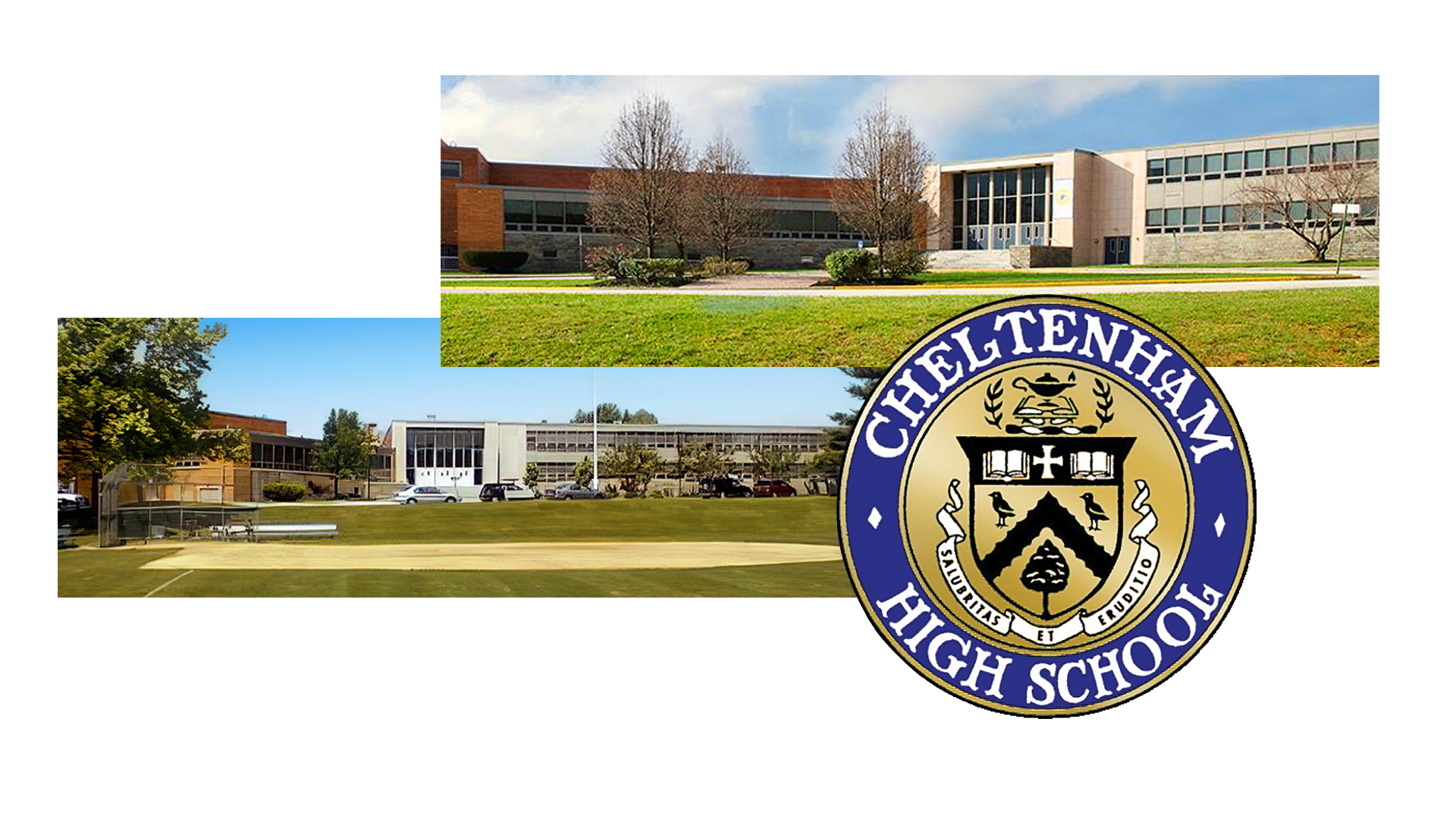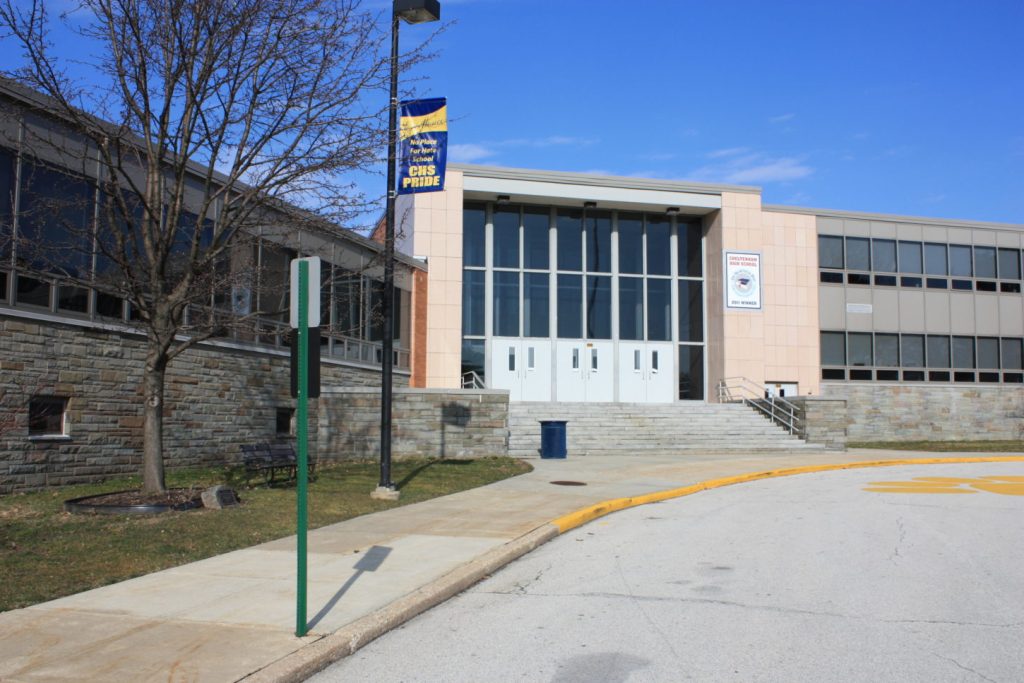

In June 1884, George W. Flounders was appointed principal of the Ashbourne School. At that time Cheltenham’s schools were for grades 1-9. As a matter of fact none of Pennsylvania’s township schools at that time had programs above the 9th grade.
In 1884, as Montgomery County was entering its second century, George W. Flounders (principal of the Ashbourne School, Grades 1-9) made a request of the Cheltenham School Board to expand the school to a complete high school. The School Board, at its December 1, 1884, meeting, officially took the step of approving Mr. Flounders’ recommendation. Mr. Flounders had already begun a class of four students, Kathryn E. Murphy, Anna L. Fenton, Gertrude Howard and Robert S. Summers, and after one year of this “advanced course,” they became Cheltenham High School’s first graduating class in June 1885. The commencement exercises were held at Parvin Hall, the Sunday School building at St. Paul’s Episcopal Church, on June 26, 1885. The first course of study included geography, history, civil government, American and English literature, rhetoric, algebra, plane geometry, Latin, physics, and chemistry.
The minutes of the September 2,1885, School Board meeting referred to the Ashbourne School for the first time as “the high school.” The first class to complete a full three year course was graduated in June 1897. A major curriculum revision creating two courses of study, Classical or Preparatory and the English, was developed in 1896. The Classical course prepared students to enter the University of Pennsylvania, Swarthmore, and Haverford Colleges. Mathematics including solid geometry and trigonometry, modern and ancient history, and literature were part of both courses. It also required three years of both Latin and German while the English course required three years of only one of the languages. The English course included bookkeeping in 10th grade and manual training in 11th grade. In June of 1896 the 9th grade students were informed as to the details of the new 3 year program so they could choose the course they intended to pursue the following September.
The distinction of being the first to receive diplomas belongs to the 12 graduates of 1894. Also, the first yearbook issued by Cheltenham High School was the trailblazing class of 1894. “Again we are the first!” the preface of the yearbook proudly proclaimed. The cover was lavender and white with gold trim. At the June 30, 1891, School Board meeting another major educational step was taken when Milton Cooper, high school principal, was asked to meet monthly with teachers from all the schools to discuss curriculum.
He reported at the October 5th meeting that a district course of study had been developed by the teachers to be used in all the grammar schools. Prior to this, while each school had a head teacher or principal, they had a local School Board member who supervised the program and building needs. Teachers were hired and teaching materials selected by the local board member. Now there would be a continuity of programs through the grades, though the local board member would still exercise some authority over his individual school.
The earliest listing of CHS Alumni Association officers that can be found dates from October 1895. One of the Alumni Association’s first acts was to design a gold pin to be awarded to the best worker of the graduating class.
No record has been found detailing the beginning of organized athletics at Cheltenham High School. In 1895 the boys organized 2 Shinny Clubs. In April 1896, the boys organized a baseball team. The real beginning of organized athletics resulted from the formation of an Athletic Association in September 1898. Following this, football, baseball, and track teams were formed to compete on a regular basis against neighboring schools. In 1906 the C.H.S. Athletic Association added a basketball team.
In 1906 the transition to a first class high school was completed by absorbing the 9th grade, which was being taught in the Wyncote School, and by making it a full 4 year high school program. This was made possible with the opening of a new high school building on March 17, 1906, at High School Road and Montgomery Avenue. It was one of the first township schools in Pennsylvania built for the specific purpose of being a high school. The 5 acre site, purchased from Martha K. Tomlinson on August 31, 1904, for $12,500, was chosen because it was centrally located and a short distance from the Elkins Park train station. Trains were one of the principal means of transportation for Cheltenham’s high school students. With the opening of the new high school, 3 courses of study were offered; college preparatory, normal preparatory and commercial. Besides a full selection of minor courses, a college preparatory student was offered the following major courses: algebra, plane geometry, solid geometry, trigonometry, Latin, German, Greek, American literature, English literature, American history, English history, Greek and Roman history, geology, botany, zoology, chemistry and physics.
The first school cafeteria program had been organized in March 1906 for the high school students. Cocoa, milk, tea, soup, sandwiches and fruit were available to both teachers and students.
Since 1884 there had always been a library facility but it was small and not systematically organized. As a matter of fact, the library had originally been opened in 1884 as the public library for the Ashbourne community. It was not well patronized so as to warrant continued township support so it was given to the school. It contained about 650 volumes of which about 450 were prose works. The new library contained 1,500 volumes. In 1907 a professional library for teachers was made available. It began with 75 current books and subscriptions to 5 educational magazines.
Beginning on October 1,1904, the provisions of the Compulsory Attendance Law were enforced in Cheltenham. The township assessor provided each school with a list of school age children living in its area. Of the 1,360 school age children living in Cheltenham Township, 1,210 were already attending school. Those not attending were teenagers who had already left school to seek permanent employment. Realizing that proper and prompt communications are important to an emerging school district, the Keystone Telephone Company was asked to connect all the schools with the main office in Ashbourne. This was completed in November of 1904.
During the 1920’s a junior high school and a new senior high school were built and a major district-wide reorganization took place. On September 8, 1926, the new high school opened its doors on what had been the athletic field behind the 1906 high school. Original plans called for the new school to be built in front of the old one, but Harrisburg authorities felt it would be too close to the Elkins Park Train Station. To replace the lost athletic facilities, 8 acres of land on the other side of High School Road were purchased for $45,000 on March 1, 1925. At the February School Board meeting in 1927, the plan to reorganize the district was accepted.
The elementary schools would be grades K-6 and 2 new junior highs would be built for grades 7-9. One was to be in Wyncote and the other in the Cheltenham area. On December 31, 1925, 9 acres of land on Hewett Road in Wyncote were purchased from William and Alice Caveny. On July 14,1928,10 acres at Ashbourne Road and Front Street were purchased from Mary Haines for $42,500. Stone was cut in the quarry behind the Hewett Road site to build both schools. It was stored on the Ashbourne Road site and work began on the Wyncote site immediately.
On September 10, 1928, the Thomas opened in Wyncote. It was named member whose father was also a School Williams Junior High School for a former School Board member and whose greatgrandfather’s will gave the land for the 1793 school on Cheltenham Avenue. The new T-W Junior High, as it was locally called, remained in use until the Cedarbrook Junior High opened in September 1970.